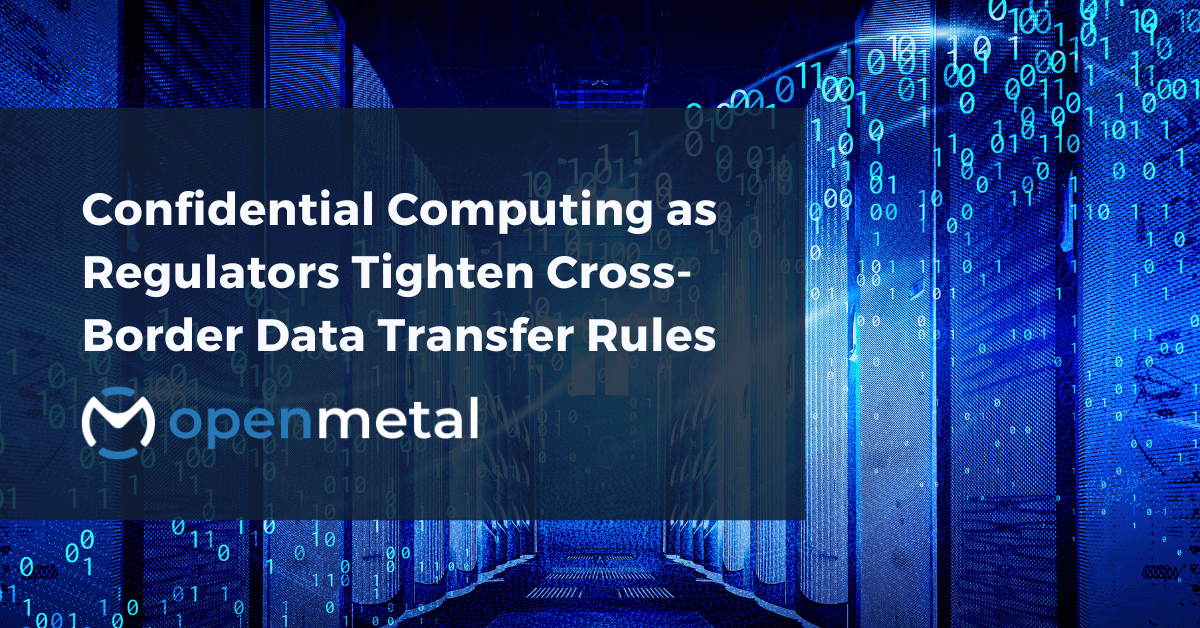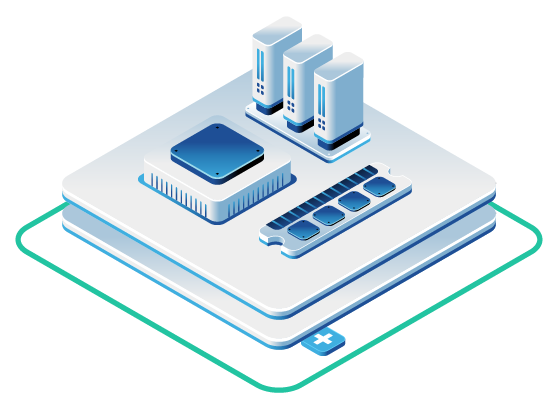
In 2025, cross-border data transfers face unprecedented scrutiny. Regulators around the world continue to restrict how organizations move personal data between jurisdictions, and the legal frameworks governing these transfers have grown more complex and less forgiving. For CTOs, CISOs, and compliance officers in regulated industries, the question is no longer whether your organization needs to address data sovereignty—it’s how you’ll do it without sacrificing operational flexibility or running up costs. Confidential computing offers a technical answer to a regulatory problem. By creating verifiable, hardware-backed environments where data remains encrypted even during processing, this approach provides assurance that sensitive workloads meet strict handling requirements—regardless of where infrastructure physically sits. When combined with regional deployment options and isolated networking, confidential computing becomes a practical framework for managing cross-border compliance without redesigning your entire data architecture.
The Regulatory Shift: Why Cross-Border Transfers Are Getting Harder
The legal landscape around international data transfers has shifted dramatically since the European Court of Justice invalidated the EU-US Privacy Shield in its 2020 Schrems II decision. That ruling established that simply signing standard contractual clauses wasn’t enough—organizations needed to assess whether the destination country’s laws provided “essentially equivalent” protection to EU standards.
Recent enforcement actions show regulators mean business. In 2023, Meta Platforms received a €290 million fine from the Irish Data Protection Commission for unlawful data transfers to the United States, despite using updated standard contractual clauses and implementing supplementary measures. This wasn’t an isolated incident. Organizations across sectors are discovering that documented compliance frameworks don’t automatically satisfy regulators when the underlying technical controls fall short.
The regulatory requirements now extend beyond Europe. Organizations must navigate requirements from GDPR in the European Union, CCPA and CPRA in California, PIPL in China, and PDPB in India—each with distinct approaches to cross-border transfers. While GDPR and UK GDPR impose strict controls on cross-border transfers without mandating outright data localization, laws like China’s PIPL and India’s PDPB explicitly require certain data to remain within national borders.
For organizations in healthcare, finance, and government, these regulations create operational constraints. You need to process data where your customers are, comply with local storage requirements, and maintain the ability to move workloads when business demands it. Traditional approaches—building separate infrastructure in each jurisdiction or accepting restrictions on where you can process data—come with tradeoffs that affect both budget and agility.
What Confidential Computing Actually Does
Confidential computing addresses a specific technical gap in data protection. While encryption at rest protects stored data and encryption in transit secures network communications, data has traditionally been vulnerable during processing—when it exists in plaintext in system memory. This is precisely where confidential computing changes the equation.
The technology relies on hardware-based Trusted Execution Environments. These are isolated processing areas within the CPU that protect workloads from the host operating system, hypervisor, and other tenants running on the same hardware. Intel Trust Domain Extensions and Intel Software Guard Extensions create these secure enclaves where computations occur on encrypted data.
The approach ensures that sensitive data and workloads execute in isolated environments where information is encrypted even while being processed. The system produces cryptographic attestations that provide assurance of secure handling—verification that the environment hasn’t been tampered with and that only authorized code is running.
This matters for compliance because regulators increasingly care about data in use, not just data at rest or in transit. When you can demonstrate that processing occurs in a hardware-verified environment where the cloud provider, system administrators, and other tenants have no access to plaintext data, you address fundamental concerns about cross-border transfers. The data may cross borders, but it remains protected by cryptographic guarantees throughout its lifecycle.
Why Regulated Industries Need More Than Standard Cloud Security
Healthcare organizations managing patient records under HIPAA, financial institutions subject to PCI-DSS requirements, and government agencies handling classified information all share a common problem: they need to process sensitive data while proving to auditors and regulators that appropriate safeguards exist.
Highly regulated industries such as healthcare and finance benefit from the privacy and security provided by confidential computing, making it easier to meet compliance requirements. Within highly competitive industries, insider threats remain a real concern—with Trusted Execution Environments in place, even system administrators and cloud service providers cannot access confidential data while it is being processed.
Traditional multi-tenant cloud environments create audit questions. Who else shares the physical hardware? What access does the provider have to your data? How do you verify that isolation actually works? These questions become harder to answer when regulators scrutinize cross-border data flows and ask you to demonstrate that foreign intelligence agencies or other actors cannot access data during processing.
Following the Schrems II decision, organizations cannot rely on Privacy Shield for EU-US transfers. Even when using standard contractual clauses, data controllers and processors must verify on a case-by-case basis whether the laws or practices of the destination country impinge on data protection. This means showing technical measures, not just contractual promises.
Confidential computing provides technical evidence. Remote attestation allows auditors to verify that workloads run in genuine Trusted Execution Environments. Measured boot confirms that only authorized code executes inside the enclave. These aren’t abstract security claims—they’re cryptographically verifiable proofs that support compliance documentation when regulators ask how you’re protecting data in use.
Infrastructure Design That Supports Regional Requirements
Compliance often comes down to geography. Companies based in one country that collect data from individuals in multiple countries must follow each jurisdiction’s data sovereignty and localization laws. Some laws set conditions around cross-border transfers, while others prohibit them altogether. In some jurisdictions, companies need to demonstrate a legal requirement to move data, retain a local copy for compliance reasons, or both.
This is where infrastructure architecture becomes a compliance tool. Isolated cluster deployments provide logical and physical separation between customer environments. When your infrastructure doesn’t share hardware, networking, or storage with other tenants, you eliminate entire categories of regulatory questions about data commingling and unauthorized access.
OpenMetal’s approach provisions infrastructure as dedicated clusters rather than multi-tenant environments. Customers control compute, storage, and networking resources directly. The networking model includes dedicated VLANs, dual 10 Gbps private links per server, and VXLAN overlay networks within OpenStack VPCs. This design creates separation for data in use and data in transit—important when regulators ask how you prevent cross-contamination between workloads or unauthorized access by other customers.
Regional deployment matters as much as technical isolation. OpenMetal operates data centers in the United States, European Union (Amsterdam), and Asia-Pacific (Singapore). These locations allow organizations to deploy workloads within specific jurisdictions to support local sovereignty and residency requirements. If GDPR requires processing EU citizen data within the EEA, or if Chinese regulations mandate local storage, you can place infrastructure where regulations demand without redesigning your architecture.
The Economics of Compliance Infrastructure
Regulatory compliance isn’t just a legal issue—it’s a budget issue. Traditional cloud pricing models charge based on consumption, egress traffic, and resource utilization. When you’re running compliance-driven workloads that need to process large volumes of sensitive data, these variable costs create budget uncertainty.
Fixed-capacity pricing based on dedicated server allocation changes this calculation. OpenMetal bills monthly charges that don’t fluctuate based on consumption or egress patterns. This helps organizations predict costs when planning infrastructure for cross-border workloads that need to meet specific regulatory requirements.
The cost predictability matters because compliance workloads often involve data-intensive processing. Healthcare research analyzing patient records, financial institutions running fraud detection models, and government agencies processing classified information all generate significant data flows. When egress charges apply to every byte that crosses network boundaries, costs become difficult to forecast. Fixed pricing eliminates this variable.
There’s also a hidden cost in multi-tenant environments: the overhead of proving isolation. When auditors ask how you guarantee that other tenants can’t access your data, you need detailed documentation of the provider’s security controls, access policies, and monitoring systems. With dedicated infrastructure, the isolation is architectural—you’re not sharing hardware, so the audit question simplifies.
Building Compliance Into Your Technical Stack
Implementing confidential computing for cross-border workloads requires more than just enabling hardware features. You need to think about the full data lifecycle: how data enters the system, where it gets processed, how it moves between regions, and what audit trail you maintain.
Start with workload assessment. Not every application needs confidential computing. Use it for processing that involves sensitive data covered by regulations, calculations on proprietary algorithms you need to protect, or multi-party computations where different organizations need to process shared data without exposing it to each other. Financial institutions running risk models, healthcare organizations analyzing patient data for research, and AI companies training models on confidential datasets all fit this pattern.
Design your network topology to match jurisdictional boundaries. If you need to process EU data under GDPR requirements, deploy infrastructure in the European Union region. If Chinese regulations require local processing, use Asia-Pacific infrastructure. The architecture should make it easy to keep data within required boundaries while maintaining the ability to move workloads when regulations or business needs change.
Implement attestation and monitoring. Remote attestation verifies that workloads run in genuine Trusted Execution Environments, providing evidence for audits and compliance reviews. Measured boot confirms the integrity of the environment. These mechanisms generate audit trails that demonstrate secure handling—documentation regulators increasingly expect when evaluating cross-border data transfers.
Consider your backup and disaster recovery strategy within the compliance context. If regulations require data to remain in a specific jurisdiction, your backups and failover infrastructure need to respect these boundaries. This is where regional deployment options become operational requirements, not just compliance checkboxes.
What This Means for Your Organization
In 2025, cross-border data transfers are becoming harder to manage because the regulatory environment has grown increasingly complex. Legal obligations vary by jurisdiction, and risk factors now include national security concerns, AI processing requirements, and vendor exposure.
For CTOs evaluating infrastructure for regulated workloads, the calculation comes down to risk versus flexibility. Hyperscaler public clouds offer scale and convenience, but their multi-tenant architectures and cross-jurisdictional operations create compliance questions. Building and operating your own data centers in multiple regions gives you control but requires significant capital investment and operational overhead.
Hosted private cloud infrastructure with confidential computing support represents a middle path. You get dedicated hardware, regional deployment options, and hardware-backed security guarantees without building and operating global data center infrastructure yourself. Bare metal servers with Intel TDX and SGX provide the foundation. Ceph storage handles data persistence with configurable replication policies that respect jurisdictional boundaries. Fixed monthly pricing through the cloud deployment calculator makes costs predictable.
For CISOs managing compliance programs, confidential computing provides technical evidence to support regulatory frameworks. You can demonstrate cryptographically that data in use receives protection, that isolation between workloads is hardware-enforced, and that attestation mechanisms verify environment integrity. These technical controls translate directly to answers for auditor questions about GDPR Article 46 safeguards, HIPAA administrative safeguards, or PCI-DSS network segmentation requirements.
For compliance officers mapping technical controls to regulatory requirements, the combination of confidential computing, regional deployment, and isolated infrastructure addresses multiple framework requirements simultaneously. GDPR Article 32 requires appropriate security measures including encryption of personal data. Schrems II demands supplementary measures beyond contractual clauses. HIPAA requires safeguards to protect electronic protected health information from unauthorized access. PCI-DSS mandates network segmentation and encryption. Confidential computing on isolated infrastructure checks all these boxes with a single technical approach.
The Path Forward
Regulatory pressure on cross-border data transfers will continue to intensify. More countries are implementing data localization requirements. Regulators are issuing larger fines for compliance failures. And the technical bar for demonstrating adequate safeguards keeps rising.
The confidential computing market reached $5.3 billion in 2023 and is expected to reach $59.4 billion by 2028, exhibiting a growth rate of 62.1% during that period. This growth reflects increasing regulatory demands and the recognition that protecting data in use requires hardware-backed security mechanisms.
For organizations in finance, healthcare, government, and other regulated sectors, the question isn’t whether to address cross-border data transfer compliance—it’s how to do it efficiently. Confidential computing provides a technical foundation. Regional deployment gives you geographic options. Isolated infrastructure eliminates multi-tenant audit questions. Fixed pricing makes costs predictable.
The technology exists. The infrastructure is available. The regulatory requirements are clear. What’s needed now is strategic thinking about how to architect your systems to meet compliance demands without sacrificing operational flexibility. That means starting with your most sensitive workloads, deploying them in regions that match your regulatory requirements, using confidential computing to protect data in use, and building documentation that shows auditors exactly how technical controls map to regulatory frameworks.
Organizations implementing these approaches need to consider the full stack—from bare metal infrastructure with hardware security features to storage systems that respect jurisdictional boundaries. Healthcare organizations have already begun this transition, recognizing that compliance isn’t just about where data sits, but how it’s processed throughout its lifecycle. The same principles apply whether you’re running financial risk models, training AI systems on GPU infrastructure, or processing government records.
The regulatory environment for cross-border data transfers continues to get more restrictive. Organizations that address these requirements with technical architecture—not just contractual agreements—will find compliance easier to achieve and defend.
Read More on the OpenMetal Blog


































